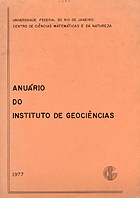Paleoclimatologia dos Depósitos Continentais Cenozóicos da Bacia de Resende
DOI:
https://doi.org/10.11137/1977_0_135-156Abstract
An examination of mineralogical data together with textural and structural aspects, from Cenozoic con tinental sediments of the Resende Basin, middle Paraiba river Valley (Rio de Janeiro, Brazil) provide some considerations about paleoclimatology in relation to deposition and source area. Based on predominance of the montmorillonite clay mineral group, unstable heavy mineral assemblage and fresh roudness feldspar contents in the deposits, the lower unit, Resende Formation, Miocene to Pliocene in age, is interpreted as deposited in semiarid climatic conditions. It is suggested that there has been a predominance of mechanical morphogenetic processes and a poor chemical weathering in the source area. The dry period recorded in the Resende Formation is related to the begginning of a extensive glaciation that covered the Antartic Continent with massive ice Sheets according to Jacobs (1974) and others and initiated prior to the late Miocene. On the other hand, the base of similar correlated formations in the brasilian coastal plain are presently found at 80 m. to 100 m. below sea level (Alexandra and Graxaim Formations). In Pliocene/Pleistocene boundary time the climate changed to a humidic type. The Fleistocene period shows great climatic instability and its interpretation is still a mather of dispute. According to Bigarella et al (1965 b) the pleistocenic sedimentary formations indicate an alternating climatic cycle caused mainly by periods of extreme climatic changes from humid to semiarid and from warm to cold. Other authors have considered such brazilian cenozoic sedimentations as related to humid climates (Almeida, 1965 and Wernick, 1966). It is not the purpose of this paper to settle all arguments on this controversial subject. Moreover, the present results of mineralogical data suggest that the Upper Formation (Floriano Fm) exhibited climatic conditions that probably changed between humid to semi-humid.Downloads
Download data is not yet available.
Downloads
Published
1977-01-01
How to Cite
Amador, E. da S. (1977) “Paleoclimatologia dos Depósitos Continentais Cenozóicos da Bacia de Resende”, Anuário do Instituto de Geociências. Rio de Janeiro, BR, 1, pp. 135–156. doi: 10.11137/1977_0_135-156.
Issue
Section
não definida
License
This journal is licensed under a Creative Commons — Attribution 4.0 International — CC BY 4.0, which permits use, distribution and reproduction in any medium, provided the original work is properly cited.















